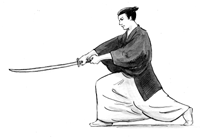
|
|
Secrets of the Samurai Sword
|

|
|
Program Overview
|

|
 NOVA gains access to Japanese foundries, swordsmiths, and fighting
schools to reveal what makes the perfect fighting sword.
NOVA gains access to Japanese foundries, swordsmiths, and fighting
schools to reveal what makes the perfect fighting sword.
The program:
-
chronicles the history of the samurai sword, which dates back to
before the 10th century.
-
outlines the several-stage manufacturing process of making the
katana, Japan's legendary samurai sword.
-
describes throughout the program what happens to the sword on an
atomic level as it is fabricated.
-
points out how the process begins when very pure, iron-bearing
river sand is combined in a clay furnace with charcoal and
heated to a near-molten state to create a pure steel known as
tamahagane.
-
explains what metals are and details the properties that make
them useful.
-
shows how small metal samples and large metal structures are
tested in university labs.
-
illustrates the similarities between samurai movies and their
modern Western counterparts and shows how samurai films
influenced the American Western.
-
clarifies the difference between iron (a naturally occurring
element) and steel (a manufactured alloy) and explains how steel
is made and why it is so much harder than iron.
-
reports that the best pieces of steel are sent on to the
swordsmith, who heats, hammers, and folds the steel repeatedly
in order to further combine the iron and carbon, and to draw out
any remaining undissolved impurities.
-
explains how the swordsmith folds and beats the steel to form a
bimetallic blade with an outer high-carbon steel shell around a
low-carbon steel interior.
-
shows how a mixture of clay and charcoal powder is pasted over
the blade's surface to further refine the sword's properties.
-
follows the sword as it travels to the final polishing stage,
where it is rubbed with a series of grinding and polishing
stones, some no larger than a grain of rice.
-
describes the life of the samurai and his code of conduct.
Taping Rights: Can be used up to one year after program is
recorded off the air.
|

|
